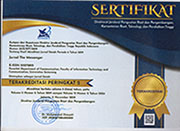News Authorship and News Sources: Impacts on Environmental Coverage in The Nigerian Press
Abstract
Keywords
Full Text:
PDFReferences
Anderson, A., Peterson, A., & David, M. (2005). Communication of Spin? Source Media Relations in Science Journalism. In S. Allan (Ed.) Journalism: Critical Issues. Maidenhead: Open University.
Berelson, B. (1952). Content Analysis in Communication Research. Glencoe, IL: Free Press.
Berkowitz, D. (1997). Social Meaning of News: A Text Reader. London: Sage.
Dunwoody, S. & Griffin, R. (1993). Journalistic strategies for reporting long-term environmental issues: A case study of three superfund sites. In A. Hasen (Ed.), The Mass Media and Environmental Issues. New York: Leicester University Press.
Fishman, M. (1980) Manufacturing the News. Austin: University of Texas Press.
Friedman, S., Dunwoody, S. & Rogers, C. (1986). Scientists and Journalists. New York: Free Press
Gans, H. (1990). Deciding What s a News: A Study of CBS Evening News, NBC Nightly News, Newsweek and Time. London: Constable.
Ginnekan, J. V. (1998). Undestanding Global news: A Critical Introduction. London: Sage.
Hall, S. (1978). Policing the Crisis. London: Macmillan.
Hannigan, J. (2006). Environmental sociology: A Social Constructionist Perspective. London: Routledge.
Holsti, O. (1969). Content Analysis for the Social Sciences and Humanities. London: Addison-Wesley Publishing Company.
Lapsansky-Werner, E. J. (2011). United States History: Modern America. Boston, MA: Pearson Learning Solutions.
Manheim, J. (1998). The News Shapers: Strategic Communication as a Third Force in News Making. In D. Graber, D. McQuail, & P. Norris (Eds.), The Politics of News: The News Politics. Washington: Congressional Quarterly Press.
Rogers, C. L. (1999). The Importance of Understanding Audiences. In S. M. Friedman, S. Dunwoody, & C.L. Rogers (Eds.), Communicating uncertainty: Media Coverage of New and Controversial Science. Mahwa, New Jersey: Lawrence Erlbaum Associates Publishers.
Schlesinger, P. & Tumber, H. (1994). Reporting Crime: The Media Politics of Criminal Justice. Oxford: Oxford University Press.
Sigal, L. (1986). Reporters and Officials: The Organization and Politics of News Making. Lexington: DC Health.
Soley, L. (1992). The News Shapers: The Sources Who Explain the News. New York: Praeger.
Bendix, J. & Liebler C. M. (November 1991). Environmental Degradation in Brazilian Amazonia: Perspectives in U.S News Media. Professional Geographer, 43, 474-485.
Berkowitz, D. & Beach D. W. (1993). News Sources and News Context: The Effect of Routine News, Conflict and Proximity. Journalism Quarterly, 70 (Spring 1993), 4-12.
Gerhards, J., & Schafer, M. S. (2009). Two Normative Models of Science in the Public Sphere: Humangenome Sequencing in German and US Mass Media. Public Understanding of Science, 18 (4), 437-451.
Greenberg, M. R., Sachsman, D. B., Sandman, P. M. & Salumone, K. L. (1989). Risk Drama and Geography in Coverage of Environmental Risk by Network TV. Journalism Quarterly, 66 (2), 267-276
Hasan, Nik, N. N. (2007). The Representation of Environmental News: A comparative Study of the Malaysian and New Zealand Press. An unpublished PhD Thesis submitted to the University of Canterbury.
Liebler, C. M. & Bendix, J. (1996). Old-Growth Forests On Network News: News Sources And The Framing Of An Environmental Controversy. J & MC Quarterly, 73 (1), 53-65.
Protess, D. et al. (1991). Making: Targeting Toxic Waste The Impact of Investigative Reporting on Public Opinion and Policy. Public Opinion Quarterly, 51, 166-185.
Sachsman, D. (1999). Commentary: Should Reporters use Risk as Detriment of Environmental Coverage? Science Communication, 21(1), 88-95.
Tuchman, G. (1972). Objectivity as Strategic Ritual: An Examination of Newsmen's Notions of Objectivity. American Journal of Sociology, 77, 660-679.
Weigold, M. (2001). Communicating Science: A Review of the Literature. Science Communication, 23 (2), 164-193.
DOI: http://dx.doi.org/10.26623/themessenger.v9i2.483
Refbacks
- There are currently no refbacks.
Copyright (c) 2017 Jurnal The Messenger
View My Stats [Jurnal The Messenger] is an International Scientific Journal, Published by the Department of Communication, Faculty of Information Technology and Communication, Universitas Semarang (Central Java, Indonesia). It is licensed under a Creative Commons Attribution 4.0 International License.



_11.jpg)




_BARCODE.jpg)
_BARCODE1.jpg)


5.png)










2.png)





